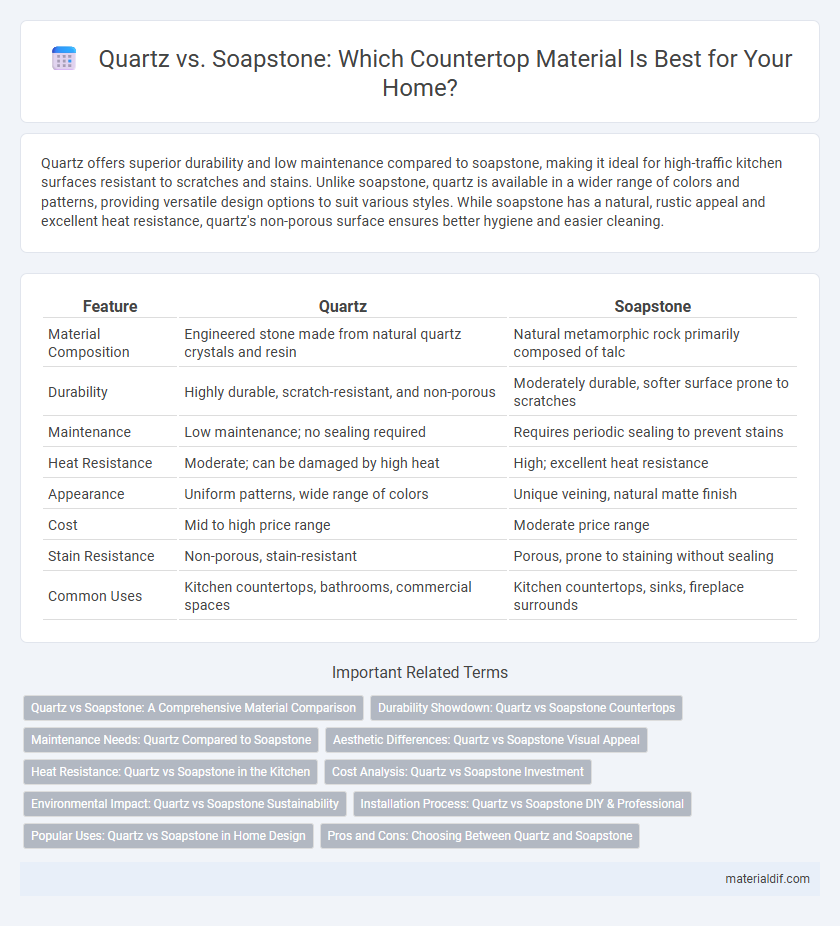Quartz offers superior durability and low maintenance compared to soapstone, making it ideal for high-traffic kitchen surfaces resistant to scratches and stains. Unlike soapstone, quartz is available in a wider range of colors and patterns, providing versatile design options to suit various styles. While soapstone has a natural, rustic appeal and excellent heat resistance, quartz's non-porous surface ensures better hygiene and easier cleaning.
Table of Comparison
| Feature | Quartz | Soapstone |
|---|---|---|
| Material Composition | Engineered stone made from natural quartz crystals and resin | Natural metamorphic rock primarily composed of talc |
| Durability | Highly durable, scratch-resistant, and non-porous | Moderately durable, softer surface prone to scratches |
| Maintenance | Low maintenance; no sealing required | Requires periodic sealing to prevent stains |
| Heat Resistance | Moderate; can be damaged by high heat | High; excellent heat resistance |
| Appearance | Uniform patterns, wide range of colors | Unique veining, natural matte finish |
| Cost | Mid to high price range | Moderate price range |
| Stain Resistance | Non-porous, stain-resistant | Porous, prone to staining without sealing |
| Common Uses | Kitchen countertops, bathrooms, commercial spaces | Kitchen countertops, sinks, fireplace surrounds |
Quartz vs Soapstone: A Comprehensive Material Comparison
Quartz offers superior durability and non-porous properties compared to soapstone, making it highly resistant to stains and scratches. Soapstone, composed primarily of talc and magnesium silicate, excels in heat resistance and develops a natural patina over time, adding unique character. Choosing between quartz and soapstone depends on factors like maintenance preferences, aesthetic goals, and intended application in kitchen or bathroom surfaces.
Durability Showdown: Quartz vs Soapstone Countertops
Quartz countertops offer superior durability with exceptional resistance to scratches, stains, and heat compared to soapstone. Soapstone is softer, making it more prone to nicks and scratches, but it can be sanded and oiled to maintain its appearance. Quartz's engineered composition provides non-porous, long-lasting surfaces ideal for high-traffic kitchen environments.
Maintenance Needs: Quartz Compared to Soapstone
Quartz requires minimal maintenance due to its non-porous surface, making it highly resistant to staining and bacterial growth. Soapstone, although durable, demands regular sealing to prevent oil absorption and maintain its appearance. Homeowners favor quartz for its ease of cleaning and low upkeep compared to the more maintenance-intensive soapstone.
Aesthetic Differences: Quartz vs Soapstone Visual Appeal
Quartz offers a wide range of vibrant colors and patterns due to its engineered composition, allowing for consistent and customizable aesthetics in kitchen countertops. Soapstone exhibits a natural, muted appearance with soft veining and a matte finish, providing a rustic and timeless look that develops a unique patina over time. The choice between quartz and soapstone depends on whether you prefer a polished, uniform surface or an organic, weathered texture that evolves with use.
Heat Resistance: Quartz vs Soapstone in the Kitchen
Soapstone offers superior heat resistance compared to quartz, enduring temperatures up to 500degF without damage, making it ideal for kitchen surfaces exposed to hot pots and pans. Quartz, composed mainly of engineered materials, can withstand heat up to approximately 150degF but is prone to discoloration or cracking with excessive heat exposure. Therefore, soapstone is preferred for heat-intensive kitchen applications, while quartz is better suited for areas with moderate heat contact.
Cost Analysis: Quartz vs Soapstone Investment
Quartz typically costs between $50 and $150 per square foot, making it a more budget-friendly option compared to soapstone, which ranges from $70 to $120 per square foot but often involves higher installation fees due to its density. Quartz offers a cost-effective solution with lower maintenance expenses over time since it is more resistant to staining and does not require periodic sealing, unlike soapstone which demands regular upkeep to preserve its appearance. An investment in soapstone entails long-term costs that can surpass its initial price advantage because of its susceptibility to scratches and the need for frequent maintenance products.
Environmental Impact: Quartz vs Soapstone Sustainability
Quartz countertops are engineered using natural quartz combined with resin and pigments, resulting in a durable surface with moderate environmental impact due to energy-intensive manufacturing processes. Soapstone, a natural metamorphic rock, is quarried with minimal processing and no harmful chemicals, making it a more sustainable choice with lower embodied energy and longer lifespan. Considering sustainability, soapstone offers a greener alternative with reduced carbon footprint and easier recyclability compared to engineered quartz surfaces.
Installation Process: Quartz vs Soapstone DIY & Professional
Quartz countertops require precise measuring and cutting, demanding specialized tools and experience for professional installation, though some DIY enthusiasts with skill can manage smaller projects using wet saws and templates. Soapstone, softer and easier to shape, allows more flexibility for DIY installations with basic woodworking tools, but professional fitting ensures proper sealing and longevity due to its natural porosity. Both materials necessitate careful handling to prevent damage, yet quartz installation is generally more complex and reliant on professional expertise compared to soapstone.
Popular Uses: Quartz vs Soapstone in Home Design
Quartz is widely favored for kitchen countertops and bathroom vanities due to its durability, non-porous surface, and low maintenance, making it ideal for high-traffic areas prone to moisture and stains. Soapstone, with its natural heat resistance and smooth texture, is popular in fireplaces, sinks, and countertops where a rustic, warm aesthetic is desired. Both materials serve distinct home design purposes, with quartz excelling in modern, sleek environments and soapstone complementing traditional or farmhouse styles.
Pros and Cons: Choosing Between Quartz and Soapstone
Quartz offers high durability, stain resistance, and a wide range of colors and patterns, making it a popular choice for modern kitchens; however, it can be more expensive and less heat resistant compared to soapstone. Soapstone provides excellent heat resistance, natural antibacterial properties, and a unique, earthy aesthetic, but it requires regular oiling to maintain its appearance and is softer, thus more prone to scratches and dents. Choosing between quartz and soapstone depends on priorities such as maintenance, aesthetic preferences, and budget constraints.
Quartz vs Soapstone Infographic

 materialdif.com
materialdif.com